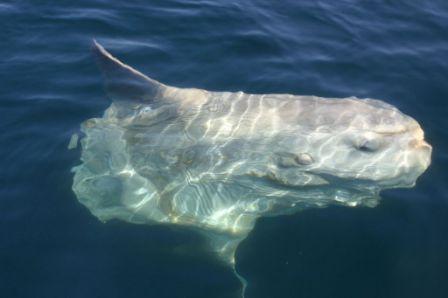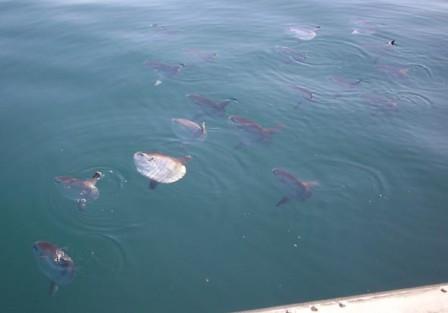
Photo credit: Bob Wyler
What on earth is that? This is a common exclamation upon meeting an ocean sunfish, the craziest looking fish inhabiting the same ocean layers humans frequent.
But this peculiar fish sports the coolest scientific name: Mola mola. Possibly Linnaeus, the father of modern taxonomy who scientifically named thousands of species, suffered a brief nervous tic and wrote the same name down twice on accident. We’ll never know what really happened, but the repetition makes Mola mola one of the easiest scientific names to remember and is frequently used by scientists and fish fans alike.
Strangeness always inspires comments and comparisons and the ocean sunfish is no exception. Top alternative ways to describe a sunfish include “a Frisbee designed by Salvador Dali” (Dr. Milton Love), “a big swimming head with fins attached” (Dr. Tierney Thys) and “a fish designed by a government committee.”
My mind conjured up an image of Victor Frankenstein leaning over the fish parts he sewed together shouting “It’s alive! It’s alive!”
In standard descriptive terms, the ocean sunfish is a roundish shaped fish that comes in a variety of gray/silver/gray-blue shades. Some sunfish have fancy shaded patterns arrayed around their bulging eyes. The front of the head slopes diagonally into a sharp nose-like point from the top and into a small puckered circular pink-lipped mouth from the bottom.
The ocean sunfish doesn’t have a normal fish tail or caudal fin; instead it has a bizarre looking stumpy rear called the clavus. “Clavus means rudder in Latin, and the sunfish uses it for steering although when they are trying to go fast they use it for propulsion as well. But it’s primarily used as a rudder,” explained Dr. Tierney Thys, marine biologist and ocean sunfish expert who also serves as director of research at the Sea Studio Foundation.
This rudder is accented by two matching fins, one sticking straight up and the other sticking straight down forming the shape of a giant hang-loose hand sign. The pectoral (side) fins seem too small for the huge round body of the ocean sunfish, making it look like the designer lost interest and stuck on the last two fins without taking proper measurements.
Despite such an unusual set-up the ocean sunfish can a reach respectable speed. According to the Monterey Bay Aquarium’s website, ocean sunfish can swim as fast as 3.2 km (two miles) per hour and can travel as far as 26 km (16 miles) in one day, which comes close to the cruising speed of the yellowfin tuna. Not too shabby. Taking into consideration the size and weight of the ocean sunfish, its speedometer rankings are even more impressive.
The ocean sunfish is the heaviest bony fish in the world (not including sharks and rays). According to a scientific paper titled “The biology and ecology of the ocean sunfish Mola mola,” the heaviest sunfish ever recorded weighed more than 5,000 pounds and was close to nine feet long. The largest ocean sunfish look like vertical flying saucers that lost their way, landed in the ocean and decided to stay.
But the alien appearance of a sunfish is deceiving since their inner mechanics are well equipped to handle an ocean environment. “Inside they are pretty much just a bag of watery muscle and their skeleton is secondarily cartilaginous [meaning made of cartilage],” said Thys. “Typically, bones are first laid down as cartilage and then they ossify, but with molas their bony skeletons have become secondarily cartilaginous which lightens them up and their muscle is quite watery which lightens up them up as well.”
“Secondarily means its ancestors had bony skeletons and then as evolution went on its lineage went further and further out into the open ocean and away from being a coral reef fish,” explained Thys. “In the open ocean having a lighter skeleton was an asset, plus a bigger body and no tail was better too.”
So the terms secondarily cartilaginous means the Mola mola evolved to have a skeleton consisting of mostly cartilage after having a bone skeleton: bone first, cartilage second. And for the sunfish this arrangement works well and allows them to haul clavus in the ocean despite their massive size.
To get around, Mola molas move their strange dorsal (back) fin and anal (bottom) fin near the clavus from side to side. The fins look like vertical wings that sometimes move in unison and sometimes independently at the back of the wacky round body. Somehow this simple system allows them to dive up to 1,000 to 2,500 feet deep.
At deep depths ocean sunfish hunt jellyfish and gelatinous zooplankton, which is a catch-all term for a group of delicate animals related to jellyfish. Luckily for Mola molas, gelatinous zooplankton is found from the ocean surface to the seafloor making it the perfect easy meal. “Typically those kinds of animals aren’t huge in calories, but their ubiquity, the fact that they’re found in lots of places may make up for what they lack in high calories,” said Thys.

Photo credit: Kris Clifford
As ocean sunfish traverse the layers of the ocean, sometimes they take time to float and lay on their side at the ocean’s surface. This is how they acquired their common “ocean sunfish” name because it looks like they are catching some rays trying to get the perfect tan.
While it’s not clear exactly what sunfish are doing at the surface, it’s possible that catching some rays isn’t that far from the truth. “We see that they tend to come to the surface in colder oceans, and spend time at the surface warming up between dives to very cold water,” said Dr. Thys. “So the working hypothesis is that they are warming themselves up.”
There are other reasons to hang loose at the surface too. “When molas are at the surface they can be cleaned by birds and have their parasites burned off by UV radiation,” said Thys. “But being at the surface is also very dangerous because you can get sunburned and birds can peck your eyes out, so it’s kind of a mixed blessing.”
But the risk may be worth it for sunfish since many parasites find their bodies to be an appealing home. Researchers have counted more than 50 parasites living on and in one Mola mola!
Ocean sunfish live in temperate and tropical waters all over the world, including off Southern California’s coast. Adults usually hang out alone, except when males and females come together during mating season to broadcast spawn in the water column. Young ocean sunfish less than two feet in length tend to hang out in schools.
Unfortunately not enough is known about the ocean sunfish to draw any firm conclusions about their population size or conservation status. This is scary considering the numbers that end up as bycatch. “Twenty-six to 29 percent of our drift gillnet bycatch is mola,” said Thys. “In California, we’re trying to get a sense of their numbers and the impact of bycatch. We have an inkling that the fisheries may be impacting the population, but it’s a little too early to say definitively.”
For readers interested in adopting a Mola mola visit www.oceansunfish.org. Your support can help ensure that these enormous, weird looking fish live to fight another day and continue to make people gasp in wonder. If you happen to see one, feel free to flash the hang-loose sign as a friendly greeting.
Leave a Reply